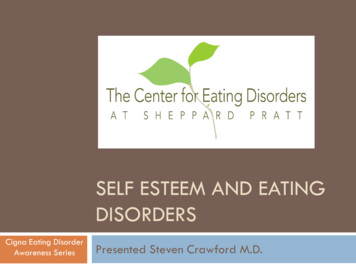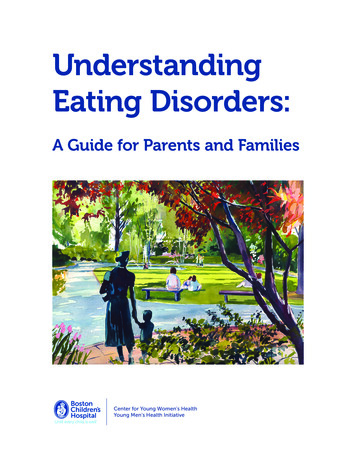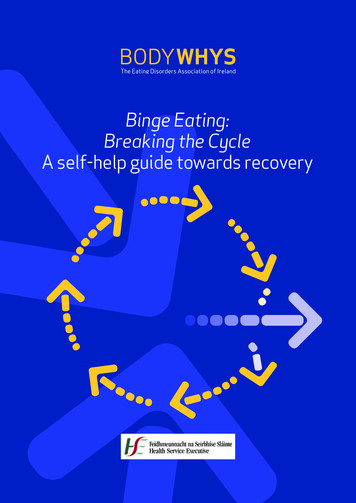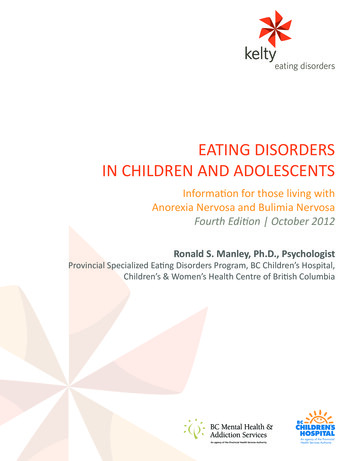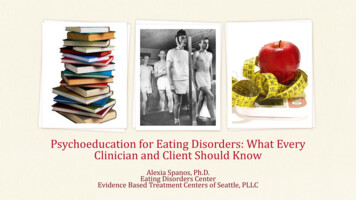
Transcription
Psychoeducation for Eating Disorders: What EveryClinician and Client Should KnowAlexia Spanos, Ph.D.Eating Disorders CenterEvidence Based Treatment Centers of Seattle, PLLC
Outline Psychoeducation for anorexia nervosa Minnesota Starvation Experiment Medical/physical impact Psychological impact Social impact Psychoeducation for bulimia nervosa Medical/physical impact Psychological/Social impact Psychoeducation for binge eating disorder and dieting Impact of Binge Eating Dieting does not work Impact of Dieting
Psychoeducation forAnorexia NervosaThe Minnesota StarvationExperiment
The Minnesota Starvation Experiment Crucial study in our understanding of what happens to the body and mind in astarved state Key part of educating a client and their family about the effects of undereatingand malnutrition Helped to dispel myths about “a disorder in vain girls” Supports weight restoration as the first intervention in evidenced-basedmanualized treatments Would never pass an IRB today
The Minnesota Starvation Experiment In 1944 36 healthy men answered a call to participate in aresearch study at the Laboratory of Physical Hygiene at theUniversity of Minnesota All were conscientious objectors of the war (many came from theHistoric Peace Churches: Mennonites, Brethren and Quaker) War was coming to an end, and Allied forces liberating parts ofEurope were encountering people in extreme starvation A young professor of physiology at the University of Minnesotawas a consultant for the War Department How would such food deprivation impact civilians physiologically andpsychologically How best to re-feed and rehabilitate them
The Minnesota Starvation Experiment Ancel Keys sent out brochures to 12,000 possible volunteersthrough work camps and Civilian Public Service sites 400 responded to the brochure 100 were interviewed and examined 36 healthy men (physically and psychologically) selected No underlying source of motivation for deprivation
The Minnesota Starvation Experiment The experiment began with a 12-week control period Approximately 3,200 calories a day Their calories were cut by approximately 50% and the six-monthsemi-starvation period began Lost 25% of their body weight by end of semi-starvation period Expected to walk 22 miles/week and participate in some work oncampus or take classes if they wished Assessments: body weight, size, and strength psychomotor and endurance tests intelligence and personality tests required to keep a personal journal
Minnesota Starvation Experiment: Physical Impact Weak physically (could not open library door or push the revolvingdoor of a department store alone) Less energy Decreased tolerance for cold temperatures, and requestedadditional blankets even in the middle of summer or spent timelying in the sun to keep warm Dizziness, extreme tiredness, anemia, neurological changes,muscle soreness, edema, skin changes, hair loss, reducedcoordination, and ringing in their ears Several were forced to withdraw from their university classesbecause they simply didn't have the energy or motivation to attendand concentrateGuetzkow, H.S. & Bowman, P.H. (1946). Men and hunger. Elgin, IL: Brethren Publishing House.
Minnesota Starvation Experiment: PsychologicalImpact Irritable and impatient with one another especially at meal times Depressed and introverted Loss of interest in sex and dating Rare to see anyone in a courtship by the end of the semi-starvationphase Lack of motivation for most activities Anhedonia for previous interests Humor was gone Rare to see anyone smile, laugh, whistle or sing Unstable moodsGuetzkow, H.S. & Bowman, P.H. (1946). Men and hunger. Elgin, IL: Brethren Publishing House.
Minnesota Starvation Experiment: Preoccupation with Food Ritualized eating behaviors emerged "They would coddle [the food] like a baby or handle it and look over it as theywould some gold. They played with it like kids making mud pies," Anxious about food and eating and would try to distract when new rations forthe week were posted on Friday nights Plate-licking was commonplace as the men sought out ways to extend mealtimeand or feel fuller “ eating became a ritual Some people diluted their food with water to makeit seem like more. Others would put each little bite and hold it in their mouth along time to savor it. So eating took a long time.” or labored over combining the food on their plate, "making weird and seeminglydistasteful concoctions,”Guetzkow, H.S. & Bowman, P.H. (1946). Men and hunger. Elgin, IL: Brethren Publishing House.
Minnesota Starvation Experiment: Preoccupation with Food Several men collected cookbooks and recipes; some reporting they ownednearly 100 by the time the experiment was over. Participants recalled the frustration of constantly thinking about food:“I don't know many other things in my life that I looked forward to being over withany more than this experiment. And it wasn't so much because of the physicaldiscomfort, but because it made food the most important thing in one's life foodbecame the one central and only thing really in one's life. And life is pretty dull ifthat's the only thing. I mean, if you went to a movie, you weren't particularlyinterested in the love scenes, but you noticed every time they ate and what theyate.”
Minnesota Starvation Experiment: Preoccupation with Food “Food became the sole source of fascination and motivation. Many men beganobsessively collecting recipes ("Stayed up until 5 a.m. last night studyingcookbooks,"). They found themselves distracted by constant daydreams of food.Some sublimated their cravings by purchasing or stealing food; one man beganstealing cups from coffee shops. They guzzled water, seeking fullness. Some took upsmoking to stave off hunger and others chewed up to 30 packs of gum a day until thelaboratory banned it. ” One subject became “euphoric” after sneaking unauthorized food in town. This leadto a binge where he visited 17 soda shops on the walk home. "He kidded with thefountain girls, thought the lights more beautiful than ever, felt that the world was avery happy place," the researchers reported. "This degenerated into a period ofextreme pessimism and remorse; he felt he had nothing to live for, that he had failedmiserably to keep his commitment of staying on reduced rations.”Guetzkow, H.S. & Bowman, P.H. (1946). Men and hunger. Elgin, IL: Brethren Publishing House.
Psychoeducation for Anorexia Nervosa: Physical Impact Death Highest mortality rate of any psychiatric illness (Sullivan, P. et al. (1995); Franko, D.L.et al. (2013)) Heart and circulation Heart muscle wastes; bradycardia; arrhythmias; low blood pressure Sex hormones and fertility Sex hormone production declines; decline in libido; decline in sexual responsiveness;decline in fertility Bones and muscles Deterioration in bone strength; osteopenia; osteoporosis; increased fracture risk Muscles waste leading to weakness GI Functioning Delayed gastric emptying; constipation; taste impairments; persistent hungerFairburn, C.G. (2008). Cognitive behavior therapy and eating disorders. New York, NY: The Guilford Press.
Psychoeducation for Anorexia Nervosa: Physical Impact Skin and hair Lanugo can grow on face, abdomen, back and arms; hair loss from the scalp; dry andorange-tinged skin Temperature regulation Decrease in body temperature and increase sensitivity to cold Sleep Less restorative and tendency to wake early Do NOT have to be underweight to experience these effects. Can also result frommarkedly undereating, irrespective of weight.Fairburn, C.G. (2008). Cognitive behavior therapy and eating disorders. New York, NY: The Guilford Press.
Psychoeducation for Anorexia Nervosa: Psychological Impact Difficultly concentrating or focusing Ritualized eating Preoccupation with food, eating and calories Cooking for others, watching cooking shows, studying nutrition, reading recipes Inflexibility in thinking and set shifting Anhedonia Irritability Depression Mood labilityCognitive Behavior Therapy and Eating Disorders. 2008. Christopher G. Fairburn. The Guilford Press, NY, NY.
Psychoeducation for Anorexia Nervosa: Social Impact Inward-looking or self-focused Heightened need for routine and difficulty being spontaneous Socially withdrawn Loss of sexual appetite IrritabilityFairburn, C.G. (2008). Cognitive behavior therapy and eating disorders. New York, NY: The GuilfordPress.
The Role of Weight Restoration Most of these problems are reversible with weight restoration Body image can also improve just by virtue of gaining weight First goal in treatment of anorexia nervosa is weight gain Psychological work can follow but is often not as helpful if clients areunderweight Many of the men in the Minnesota Starvation Experiment saw physical improvementsbefore psychological improvement (much improvement in mood and social behavioroccurred three months later) But it took longer to stabilize eating (many became grazers and others continued toengage in binge eating, even eight months later) This is why in CBT-E and FBT a key component of treatment is re-establishing aregular pattern of eating
Psychoeducation for Bulimia Nervosa Check the facts Self-induced vomiting is not an effective method of weight lossbecause some of the calories are still absorbed Laxatives also are not effective for weight loss (only 10-12% ofingested calories are lost this way) because laxatives do not act on thesmall intestine (act on the large intestine), which is the primary site ofcalorie absorption (Mehler, P.S., Crews, C. & Weiner, K. (2004). Bulimia: Medical complications.Journal of Women’s Health, (13)6, 668-675) Most people with bulimia nervosa are normal weight oroverweight
Psychoeducation for Bulimia Nervosa: Physical Impact Self-induced Vomiting Pharyngeal soreness (irritation in back of the throat by stomach acid) Dental erosion (made worse by rinsing the mouth after vomiting), dentalcaries and periodontal disease (irreversible but not progressive) Sialadenosis painless swelling of salivary glands has been reported in 10–50% of patients, depending on the frequency of vomiting. Initiallyintermittent, the swelling tends to persist Esophagitis, esophageal erosions, ulcers, and bleeding. Thus, patients withbulimia nervosa often complain of heartburn and acid-reflux symptoms Esophageal rupture is rare but fatal in 20% of cases Callouses on knuckles (Russell’s sign) Self-induced vomiting using ipecac syrup can be fatal because repeatedingestions results in accumulation of emetine which leads to cardiaccomplications and sudden death may follow.Mehler, P.S., Crews, C. & Weiner, K. (2004). Bulimia: Medical complications. Journal of Women’s Health, (13)6, 668-675.
Psychoeducation for Bulimia Nervosa: Physical Impact Laxative abuse Tolerance to the effects of stimulant laxatives occursCathartic colon syndrome: loss of normal functioning of your colonSevere constipation (very prolonged use can be irreversible)No way to predict how when this may occurMay retain water for a week when stop abruptly if using regularlyHarmless reflex constipation can occur when someone it trying todiscontinue laxative use. Usually can return to normal functioning ifthey can tolerate it or decrease with the help of a physician.Mehler, P.S., Crews, C. & Weiner, K. (2004). Bulimia: Medical complications. Journal of Women’s Health, (13)6, 668-675.
Psychoeducation for Bulimia Nervosa: Physical Impact Irregular periods and infertility (can resolve with regular eating and no purging) Excessive/compulsive exercise Rigid thinking Dehydration Overuse injuries Electrolyte imbalance Low potassium (hypokalemia) which can cause cardiac problems or death (irregularheart beats should be checked by a physician) Edema of lower extremities Dehydration which can cause renal failure Reversible and stops with purging but may need supervision of a physicianFairburn, C.G. (2013). Overcoming binge eating second edition: the proven program to learn why you binge and how you canstop. New York, NY: The Guilford Press.
Psychoeducation for Bulimia Nervosa: Psychological/Social Impact Binge eating occurs for the following reasons Physiological deprivation Psychological deprivation Mood regulation Isolating Shameful Depression Mood lability Anxiety about eating and food (dietary restraint/restriction)Fairburn, C.G. (2013). Overcoming binge eating second edition: the proven program to learn why you binge and how you can stop.New York, NY: The Guilford Press.
Psychoeducation for Binge Eating Disorder and Dieting: Impact of Binge Eating Discuss the reasons people binge eat Goals of treatment is not weight loss, it is to stop binge eating and establishregular eating Pattern of restriction or culturally-sanctioned dieting perpetuates binge eating Must avoid weight loss programs that encourage strict dieting or forbid theconsumption of specific foods Binge eating can change the cues for hunger and satiety Can cause weight gain or maintenance of obesityFairburn, C.G. (2013). Overcoming binge eating second edition: the proven program to learn why you binge and how youcan stop. New York, NY: The Guilford Press.
Dieting Does NOT Work Not as simple as calories in and calories out Set-point theory (humans evolved to be famine resistant) Too restrictive so difficult to maintain long-term Individual differences in weight gain/loss Overfeeding by 1,000 calories/day leading to weight gain of 9-29 lbs depending on theperson (Bouchard et al., 1990) Behavior genetics studies (twin and adoption) show genetics play asignificant role in weight Adopted children’s weight correlates with biological parents Up to 70% of variance for weight (height is 80%)McElfish, B.M. (2018). Dieting: The rarely successful, the hangry, and the eating disordered. Presentation for CEat EBTCS.
Dieting does NOT work“It is only the rate of weight regain, not the fact of weightregain that appears to be open to debate.”- Garner & Wooley, “Confronting the Failure of Behavioral and Dietary Treatments for Obesity,”Clinical Psychology Review 11, no. 6 (1991): 729-80.“If ‘cure’ from obesity is defined as reduction to ideal weightand maintenance of that weight for 5 yeas, a person is morelikely to recover from most forms of cancer than from obesity.”-Brownell, “Obesity: Understanding and Treating a Serious, Prevalent, and RefractoryDisorder,” Journal of Consulting and Clinical Psychology 50, no. 6(1982): 820-40.McElfish, B.M. (2018). Dieting: The rarely successful, the hangry, and the eating disordered. Presentation for CE atEBTCS.
Dieting Does NOT Work Evidence that the pattern of restriction and then weight regain may actually becontributing to the obesity epidemic More likely to notice and pay attention to food Particularly strong in obese people, and get stronger the more you diet Hormones (Kershaw & Flier, 2003) Feeling full (leptin, peptide YY, and cholecystokinin) decrease, hungry (ghrelin, gastric inhibitory polypeptide, and pancreatic polypeptide) increase Changes still detectible a year after ceasing dietingMcElfish, B.M. (2018). Dieting: The rarely successful, the hangry, and the eating disordered. Presentation for CE at EBTCS.
Impact of Dieting Losing weight leads to dependence on lower energy requirements (Leibel &Hirsch, 1995) Weight cycling is associated with increased risk of illness and death (Brownell &Rodin, 1994) Faster cell death (muscles weakening, skin wrinkling, hearing, eyesight and thinkingdiminishes) Diverts energy from reproduction, growth, immune system Over time you become more susceptible to infection. Bone density decreases, Your bloodpressure increases as heart has to work harder and blood vessels get damaged. Body becomesmore resistant to insulin and increasingly stores fat in abdomen.McElfish, B.M. (2018). Dieting: The rarely successful, the hangry, and the eating disordered. Presentation for CE at EBTCS.
Impact of Dieting More emotionally vulnerable/labile Minnesota Semi-Starvation Experiment Disordered eating Poorer immediate memory, longer reaction times Decrease in executive functioning, which returns after ceasing diet Dieting leads to increase in stress responseMcElfish, B.M. (2018). Dieting: The rarely successful, the hangry, and the eating disordered. Presentation for CE at EBTCS.
Dieting does NOT work: Health at Every SizeStudy of over 11k individuals of varying BMI showed risk of death over 14 yearsbased on 4 healthy habits:1. Eating enough fruits and veggies2. Exercise 3x/week3. Not smoking4. Drinking in moderationMcElfish, B.M. (2018). Dieting: The rarely successful, the hangry, and the eating disordered. Presentation for CE at EBTCS.
Dieting does NOT work: Health at Every SizeMcElfish, B.M. (2018). Dieting: The rarely successful, the hangry, and the eating disordered. Presentation for CE at EBTCS.
Citations Keys, A., Brozek, J., Henshel, A., Mickelson, O., & Taylor, H.L. (1950). The biology of humanstarvation, (Vols. 1–2). Minneapolis, MN: University of Minnesota Press. Guetzkow, H.S. & Bowman, P.H. (1946). Men and hunger. Elgin, IL: Brethren Publishing House. Mehler, P.S., Crews, C. & Weiner, K. (2004). Bulimia: Medical complications. Journal of Women’sHealth, (13)6, 668-675) Fairburn, C.G. (2008). Cognitive behavior therapy and eating disorders. New York, NY: TheGuilford Press. Fairburn, C.G. (2013). Overcoming binge eating second edition: the proven program to learn whyyou binge and how you can stop. New York, NY: The Guilford Press. McElfish, B.M. (2018). Dieting: The rarely successful, the hangry, and the eating disordered.Presentation for CE at EBTCS. Sullivan., P. (1995). Mortality in anorexia nervosa. American Journal of Psychiatry, 152(7). Franko, D.L., et al. (2013). A longitudinal investigation of mortality in anorexia nervosa andbulimia nervosa. American Journal of Psychiatry, 170(8).
Psychoeducation for Binge Eating Disorder and Dieting: Impact of Binge Eating Discuss the reasons people binge eat Goals of treatment is not weight loss, it is to stop binge eating and establi
